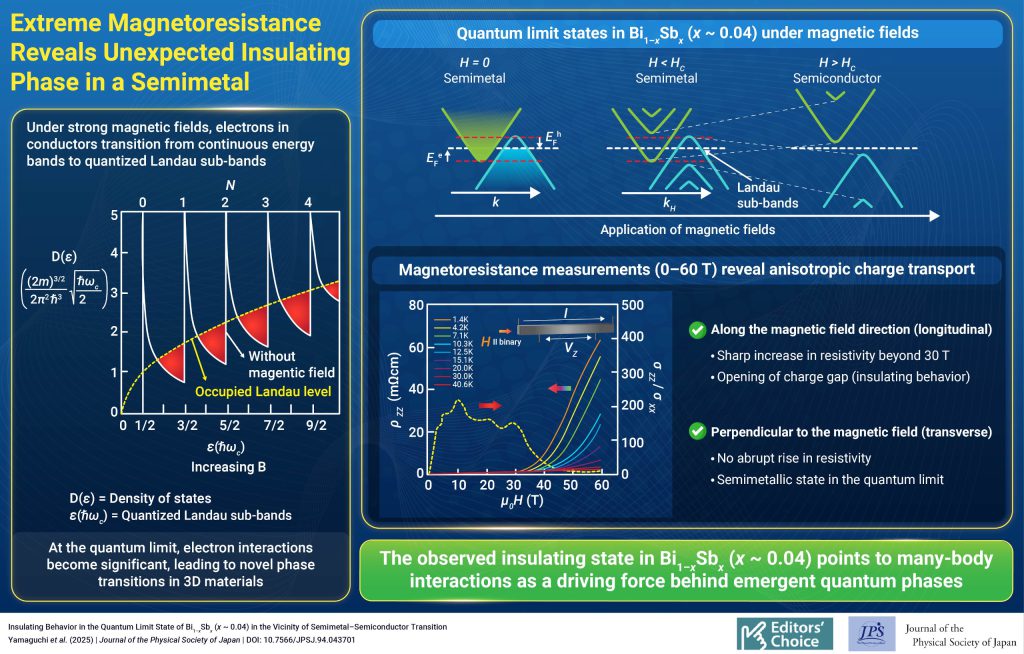Extreme Magnetoresistance Reveals Unexpected Insulating Phase in a Semimetal
© The Physical Society of Japan
This article is on
Insulating Behavior in the Quantum Limit State of Bi1-xSbx (x ∼ 0.04) in the Vicinity of Semimetal-Semiconductor Transition
(JPSJ Editors’ Choice)
J. Phys. Soc. Jpn.
94,
043701
(2025)
.
We discovered an anomalous quantum state in which electric conduction exhibits a gapped behavior exclusively in one direction, in the quantum limit of the BiSb alloy under strong magnetic fields.

We can realize a quantum limit in extremely strong magnetic fields, where all charge carriers in metals occupy only the lowest-energy quantum state. Further increases in the magnetic field suppress the kinetic degrees of freedom of the carriers and incorporate electron correlation effects. Understanding the types of quantum states emerging from strongly correlated three-dimensional materials in the quantum limit remains a significant challenge, as magnetic fields exceeding 10,000 T are required to reach this state in conventional metals.
We investigated the semimetallic BiSb alloy to explore this novel quantum state in the quantum limit. Applying magnetic fields perpendicular to the three-fold rotational axis of this material reduces the overlap between the conduction and valence bands, inducing a semimetal-semiconductor transition at a specific magnetic field. Consequently, we can delve deeper into the quantum limit in fields slightly below this transition field. Our transverse magnetoresistance measurements (with current perpendicular to the magnetic field) exhibited clear quantum oscillations, indicating that the material remains semimetallic and reaches the quantum limit for both electron and hole carriers in magnetic fields up to 60 T. In contrast, the longitudinal magnetoresistance (with current parallel to the magnetic field) showed steep increase at magnetic fields above 30 T. Analysis of the transport data revealed a gap of a few meV only during conduction along the magnetic field, with no corresponding gap observed in the energy diagram calculated for single-particle states that neglect electron correlation effects.
Further investigations are required to clarify the origin of this anomalous insulating state in the quantum limit. Similar anisotropic insulating behaviors have recently been observed in several topological semimetals under high magnetic fields. It would be interesting to explore the tunable electron correlation effects, influenced by magnetic fields, in topological semimetals.
(Written by Masashi Tokunaga on behalf of all authors.)
Insulating Behavior in the Quantum Limit State of Bi1-xSbx (x ∼ 0.04) in the Vicinity of Semimetal-Semiconductor Transition
(JPSJ Editors’ Choice)
J. Phys. Soc. Jpn.
94,
043701
(2025)
.
Share this topic
Fields
Related Articles
-
A Unified Theory of Topological Hall Effect
Electronic transport in condensed matter
2025-3-6
This paper presents a unified theoretical description for the topological Hall effect, covering the entire region from strong- to weak-coupling, extending its picture beyond the Berry phase.
-
Excitonic Insulators: Challenges in Realizing a Theoretically Predicted State of Matter
Electron states in condensed matter
Electronic transport in condensed matter
2025-3-3
The realization of an excitonic insulator can help in the establishment of a new electronic state in condensed matter physics, one that has the potential to exhibit novel electric, magnetic, and optical responses beyond those of conventional materials.
-
Triangular Lattice Magnet GdGa2: Spin Cycloids and Skyrmions
Cross-disciplinary physics and related areas of science and technology
Electronic transport in condensed matter
Magnetic properties in condensed matter
2025-2-3
Careful measurements were conducted on the hexagonal magnet GdGa2 to reveal the experimental signatures of ultrasmall spin cycloids and of a potential Néel-type skyrmion lattice phase induced by a magnetic field.
-
Large Thermoelectric Effect in High Mobility Semimetals
Electronic transport in condensed matter
2024-12-23
This study clarifies that the high mobility semimetal Ta2PdSe6 generates large Seebeck and Nernst effects at low temperatures, providing insight for exploring good thermoelectric materials for low-temperature applications.
-
The Stiffness of Electronic Nematicity
Dielectric, optical, and other properties in condensed matter
Electronic structure and electrical properties of surfaces and nanostructures
Electronic transport in condensed matter
2024-11-21
Using laser-excited photoelectron emission microscope (laser-PEEM) we found that the nematic stiffness in iron-based superconductors significantly increases as the systems become strange metals, suggesting that spin–orbital fluctuations enhance the stiffness of electronic nematicity.




